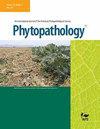求助PDF
{"title":"Overexpression of α-SNAP<sub>Rhg1</sub> Can Improve <i>rhg1-a</i>-Mediated Soybean Resistance to Soybean Cyst Nematode.","authors":"Deepak Haarith, Soumita Das, Emma Nelson, Ryan Zapotocny, Andrew F Bent","doi":"10.1094/PHYTO-02-25-0077-R","DOIUrl":null,"url":null,"abstract":"<p><p>The <i>rhg1-a</i> and <i>rhg1-b</i> haplotypes of the soybean <i>Rhg1</i> locus are economically effective tools for the control of soybean cyst nematode (SCN; <i>Heterodera glycines</i>), but ongoing SCN evolution requires improved sources of resistance. Both <i>Rhg1</i> haplotypes carry multiple tandem repeat copies of a four-gene block encoding four disparate proteins, and resistance efficacy scales with copy number. The haplotypes encode different variants of an unusual α-SNAP protein whose abundance increases in the nematode-reprogrammed plant cells that form the syncytium (nematode feeding site), which subsequently collapses. The present study explored the simultaneous presence of two α-SNAP<sub>Rhg1</sub> protein types and elevation of α-SNAP<sub>Rhg1</sub> abundance, which were hypothesized to improve SCN resistance but are not achievable by conventional soybean breeding. We accomplished both via transgenic additions to an <i>rhg1-a Rhg4</i> soybean line. Existing resistance to the HG type 0 and HG type 2.5.7 SCN was strengthened, measured as cyst production and final SCN egg counts, but resistance was not improved against an HG type 1.3.6.7 SCN population that was already highly virulent on the parent line. Greenhouse and field studies with a subset of lines showed no significant yield penalties. We conclude that cisgenic combination or elevated expression of the different α-SNAP genes may extend the efficacy and/or durability of <i>Rhg1</i>-mediated resistance. We also observed differential protein abundances for some α-SNAP<sub>Rhg1</sub> isoforms after inoculation with different HG type populations of SCN. The studies provide a foundation for further refinement of <i>Rhg1</i>-based SCN control. [Formula: see text] Copyright © 2025 The Author(s). This is an open access article distributed under the CC BY-NC-ND 4.0 International license.</p>","PeriodicalId":20410,"journal":{"name":"Phytopathology","volume":" ","pages":"1165-1174"},"PeriodicalIF":3.1000,"publicationDate":"2025-09-01","publicationTypes":"Journal Article","fieldsOfStudy":null,"isOpenAccess":false,"openAccessPdf":"","citationCount":"0","resultStr":null,"platform":"Semanticscholar","paperid":null,"PeriodicalName":"Phytopathology","FirstCategoryId":"97","ListUrlMain":"https://doi.org/10.1094/PHYTO-02-25-0077-R","RegionNum":2,"RegionCategory":"农林科学","ArticlePicture":[],"TitleCN":null,"AbstractTextCN":null,"PMCID":null,"EPubDate":"2025/9/9 0:00:00","PubModel":"Epub","JCR":"Q2","JCRName":"PLANT SCIENCES","Score":null,"Total":0}
引用次数: 0
引用
批量引用
Abstract
The rhg1-a and rhg1-b haplotypes of the soybean Rhg1 locus are economically effective tools for the control of soybean cyst nematode (SCN; Heterodera glycines ), but ongoing SCN evolution requires improved sources of resistance. Both Rhg1 haplotypes carry multiple tandem repeat copies of a four-gene block encoding four disparate proteins, and resistance efficacy scales with copy number. The haplotypes encode different variants of an unusual α-SNAP protein whose abundance increases in the nematode-reprogrammed plant cells that form the syncytium (nematode feeding site), which subsequently collapses. The present study explored the simultaneous presence of two α-SNAPRhg1 protein types and elevation of α-SNAPRhg1 abundance, which were hypothesized to improve SCN resistance but are not achievable by conventional soybean breeding. We accomplished both via transgenic additions to an rhg1-a Rhg4 soybean line. Existing resistance to the HG type 0 and HG type 2.5.7 SCN was strengthened, measured as cyst production and final SCN egg counts, but resistance was not improved against an HG type 1.3.6.7 SCN population that was already highly virulent on the parent line. Greenhouse and field studies with a subset of lines showed no significant yield penalties. We conclude that cisgenic combination or elevated expression of the different α-SNAP genes may extend the efficacy and/or durability of Rhg1 -mediated resistance. We also observed differential protein abundances for some α-SNAPRhg1 isoforms after inoculation with different HG type populations of SCN. The studies provide a foundation for further refinement of Rhg1 -based SCN control. [Formula: see text] Copyright © 2025 The Author(s). This is an open access article distributed under the CC BY-NC-ND 4.0 International license.
过表达α-SNAPRhg1可提高rhg1-a介导的大豆对大豆囊肿线虫的抗性。
大豆Rhg1基因座的Rhg1 -a和Rhg1 -b单倍型是防治大豆囊肿线虫(SCN;异源类甘氨酸),但持续的SCN进化需要改进抗性来源。两种Rhg1单倍型都携带编码四种不同蛋白质的四基因块的多个串联重复拷贝,抗性效果与拷贝数有关。单倍型编码一种不寻常的α-SNAP蛋白的不同变体,该蛋白的丰度在线虫重编程的植物细胞中增加,形成合胞体(线虫的取食部位),合胞体随后崩溃。本研究探索了两种α-SNAPRhg1蛋白类型的同时存在和α-SNAPRhg1丰度的升高,这被假设可以提高大豆对SCN的抗性,但这是传统大豆育种无法实现的。我们通过将转基因添加到一个rhg1-a - Rhg4大豆品系上,完成了这两项工作。对HG - 0型和HG - 2.5.7型SCN的抗性得到了增强,以包囊产量和最终SCN卵数来衡量,但对在亲本上已经具有高毒力的HG - 1.3.6.7型SCN群体的抗性没有提高。对部分品系进行的温室和田间研究表明,对产量没有显著影响。我们得出结论,顺基因组合或不同α-SNAP基因的表达升高可能延长rhg1介导的抗性的有效性和/或持久性。我们还观察到不同HG型SCN群体接种后,某些α-SNAPRhg1亚型的蛋白丰度存在差异。这些研究为进一步完善基于rhg1的SCN控制奠定了基础。
本文章由计算机程序翻译,如有差异,请以英文原文为准。

 求助内容:
求助内容: 应助结果提醒方式:
应助结果提醒方式:


